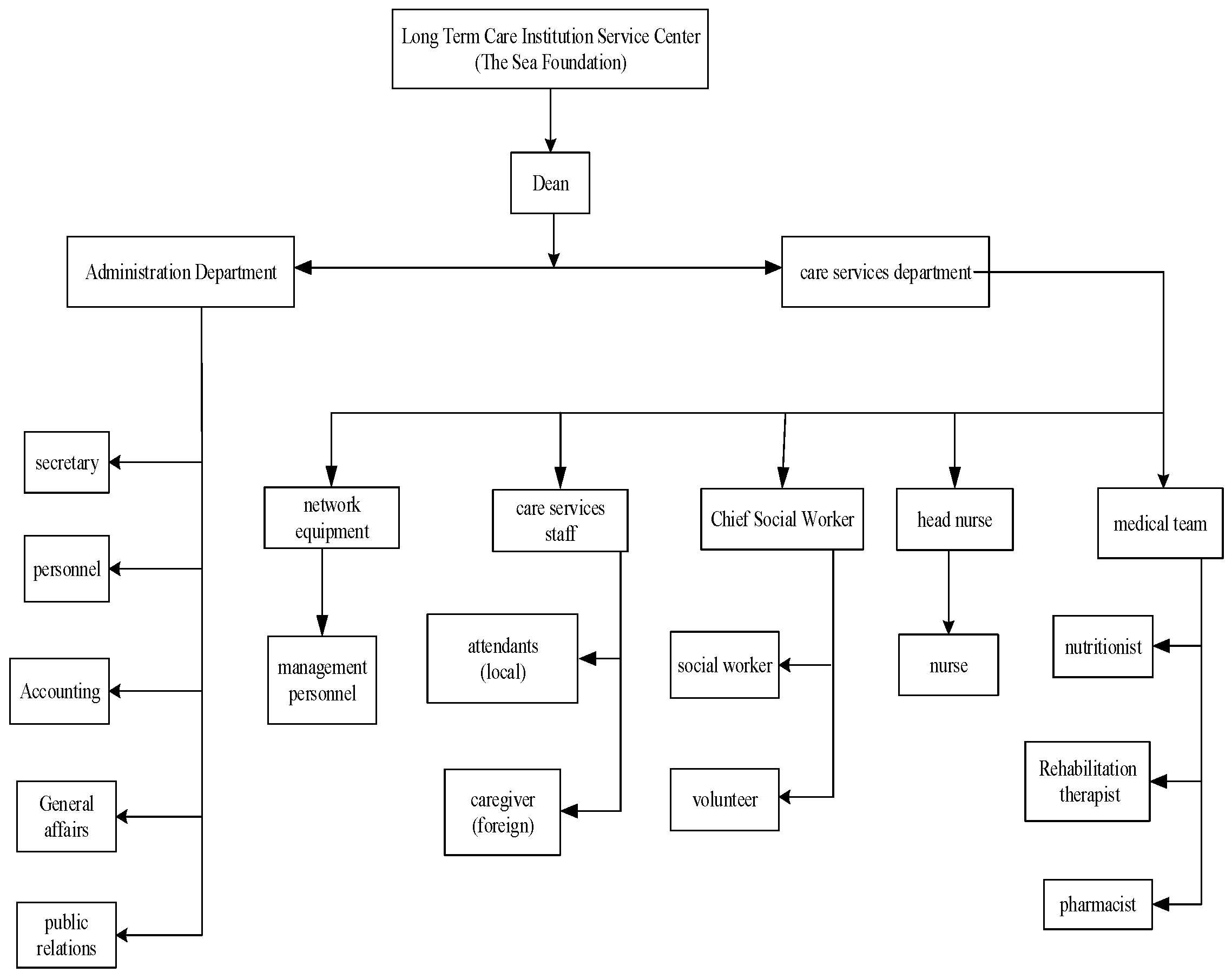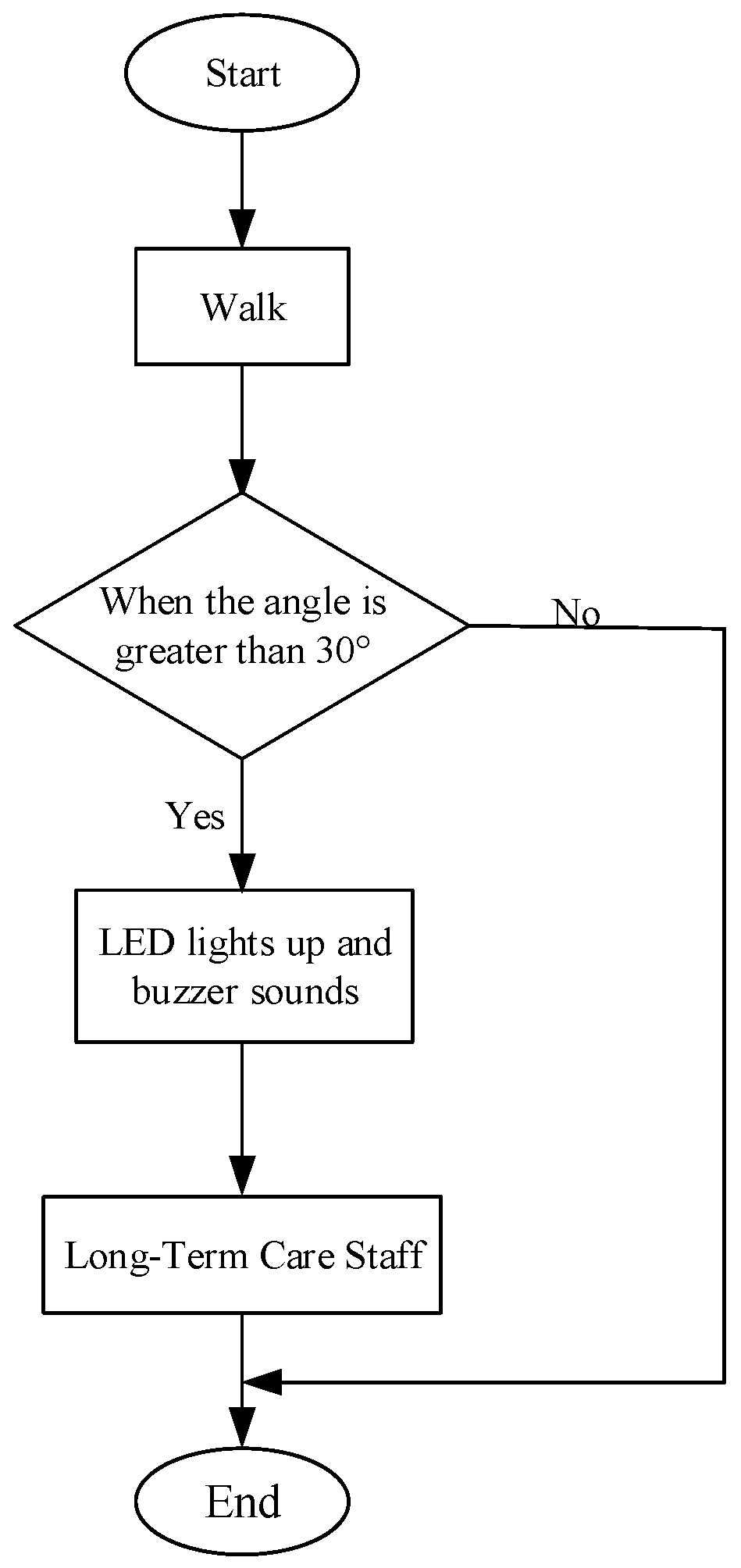Integrating Internet with Long-Term Care Management Policy with the Internet †
Abstract
1. Introduction
2. System Architecture
- Dean is responsible for managing the affairs of the service center.
- Administrative departments are divided into secretary, human resources, accounting, general affairs, and public relations teams.
- Secretary is responsible for document processing, meeting notices, and all meeting minutes, and submitting the compiled information to the dean.
- Personnel for recruiting and interviewing applicants and are responsible for personnel promotion and transfer matters.
- Accountant develops budgets based on actual needs and is responsible for financial revenue, expenditures, and employee salaries.
- General affair team is responsible for the management and procurement of center equipment.
- Public relations team uses social media to discuss cooperation and promote the center.
- Care service departments are divided into medical, head nurse, social worker, care service staff, and network equipment teams.
- Medical teams include nutritionists, physical therapists, and pharmacists.
- Nutritionist is a professional with food and nutritional medicine who is responsible for everyone’s diet and nutrition.
- Rehabilitation therapist with a license and a medical background is responsible for providing physical therapy to elders with limited mobility.
- Pharmacist dispenses medications and provides drug consultations to patients according to doctor’s prescriptions.
- Head nurse is responsible for managing and teaching nurses how to care for patients.
- Nurse with a license is responsible for the medical care and health education of patients.
- Chief social worker is responsible for training and management.
- Social workers have qualified licenses in the national examination and are responsible for assisting patients with subsidies for low- and middle-income households, caring for patients’ emotions, and organizing group health activities on a regular basis.
- Volunteers have a passion for service but need training and are responsible for keeping the environment clean and assisting social workers.
- Care service staff includes attendants (local) and the other is caregivers (foreigners).
- Attendants: need to be trained and pass the test. They are responsible for taking care of the patient’s diet and daily life and accompanying the rescuers.
- Caregivers undergo basic professional training and have native language skills, and their responsibilities are the same as those of caregivers.
- Network equipment includes cameras, computer centers, wireless or line networks, and sensor devices (MPU6050, LED lights, and buzzers).
- Management personnel report the condition of patients at any time and have professional maintenance skills.
- Start: When the elderly person is standing.
- Walking: Begin walking slowly.
- When the tilt angle is greater than 30 degrees, the LED light turns on and the buzzer sounds, prompting the caregiver to intervene.
3. Methodology
4. Results
- Emphasis on commissioners and voters: Promotes public participation and democratic governance, understanding the needs and expectations of voters, enabling policymakers to create policies that better align with the public interest, thereby enhancing government trust and accountability.
- Cost-effectiveness: The public sector, through clear analysis, can more effectively allocate limited resources, optimize expenditures, improve service quality, and reduce unnecessary costs.
- Emphasis on policy analysis: Policy analysis focuses on data-driven and evidence-based decision-making, conducting policy evaluations and improvements to help decision-makers make more informed choices.
- Bureaucratism: Overemphasis on rules and procedures stifles innovation and problem-solving, leading to inefficiencies.
- Oversimplified Management Concepts: Management issues are simplified, neglecting complex factors in real situations, which may fail to address rapidly changing environments and needs, leading to poor decision-making.
- Government-Controlled Administration: Leads to opaque decision-making processes, restricts local departments’ autonomy, reduces public participation, undermines trust, and decreases administrative efficiency, ultimately impacting service quality.
- Rapid service delivery: By streamlining processes, it enhances public trust and satisfaction with government agencies, allowing them to meet public demands more quickly, thus making the organization more competitive in terms of service quality.
- Reduction in excessive workforce: Streamlining human resources increases workflow efficiency, improves organizational professionalism, reduces operational costs, and concentrates resources on core tasks.
- Greater flexibility: A flexible working environment fosters innovative thinking, and enables quick adaptation to policy and market changes, and flexible work arrangements enhance employee satisfaction, increasing work enthusiasm and loyalty.
- Failure to achieve social justice: Market-driven and competition-based policies may lead to unequal resource distribution, prioritizing profit over public interest, ignoring social responsibilities and ethical considerations, thus exacerbating social inequality and service quality decline.
- Neglect of community awareness: An overemphasis on market mechanisms may lead to neglect of community awareness and participation, failing to consider local specific needs and cultural contexts, thus decreasing public trust in the government, and affecting community development.
- Lack of public participation in decision-making: The decision-making process is relatively closed, with the public unable to effectively participate in policy formulation and execution, which fails to fully consider the public’s perspectives and needs, leading to resistance and dissatisfaction with government policies and impacting their effectiveness.
- Focus on customers: By understanding customer needs and expectations, businesses can offer products and services that better meet these demands, enhancing customer loyalty to the brand and standing out in market competition.
- Focus on cost efficiency: Through the evaluation of costs and benefits, businesses continuously seek methods to improve processes and increase efficiency. This allows for more effective resource allocation, enabling the company to invest in innovation projects and develop new products and services.
- Focus on performance evaluation: Regular performance evaluations help identify issues and weaknesses, develop improvement plans, set clear goals, and establish reward mechanisms to boost employee motivation.
- Competition with government agencies: Business operations may be affected by government policies. Government agencies may have market monopolies or special privileges, and businesses often face insufficient resources, funding, and policy support, making it difficult to compete with the resources allocated to government entities.
- Lack of quality assurance: A lack of quality assurance can reduce customer trust in products or services, leading to customer attrition. It may also result in legal liabilities or compensation claims, damaging the brand image and market reputation.
- Lack of transparency in promotion Channels: Non-transparent promotion channels can lead to employee dissatisfaction, affecting their motivation and causing talent loss within the company.
- Ineffective management systems: In a rapidly changing market environment, the absence of effective management systems may expose the company to higher risks, leading to disorganized processes, poor communication, and difficulty in adapting to new challenges and opportunities.
- Reduced labor: Automated and digitized network management systems improve work efficiency, reduce the financial burden on central operations, and allow employees to focus their time and energy on more technical tasks.
- Cost reduction: Stable network equipment reduces the frequency of system failures and repairs, effectively lowering operational costs.
- Convenient management: Network management systems allow for centralized monitoring and management of various resources, providing real-time data and reports that help managers make quick decisions, making management more efficient and convenient.
- Stable service: Effective network equipment ensures system stability, enhancing user satisfaction and strengthening brand trust.
- Security issues: Network management systems may face risks of data breaches. If the system is not regularly updated or properly configured, security vulnerabilities may exist, potentially leading to legal risks and fines.
- Need for specialized maintenance: Professional network administrators are required for system maintenance and monitoring. As technology evolves, these professionals need to continuously update their skills and knowledge. However, over-reliance on specialists may lead to operational disruptions or loss of knowledge.
5. Conclusions
Author Contributions
Funding
Institutional Review Board Statement
Informed Consent Statement
Data Availability Statement
Acknowledgments
Conflicts of Interest
References
- Huang, P.C.; Lin, C.C.; Wang, Y.H.; Hsieh, H.J. Development of Health Care System Based on Wearable Devices. In Proceedings of the 2019 Prognostics and System Health Management Conference (PHM-Paris), Paris, France, 2–5 May 2019; pp. 249–252. [Google Scholar]
- Ni, L.; Sun, Y.; Yang, Y.; He, L. Human-Engaged Health Care Services Recommendation for Aging and Long-term Care. In Proceedings of the 2019 IEEE 23rd International Conference on Computer Supported Cooperative Work in Design (CSCWD), Porto, Portugal, 6–8 May 2019; pp. 339–344. [Google Scholar]
- Luo, Y.; Kubo, M.; Kobayashi, Y.; Fukunishi, H. Long-Term Care Risk Prediction by Claims Data Analysis. In Proceedings of the 2020 IEEE International Conference on Healthcare Informatics (ICHI), Oldenburg, Germany, 30 November–3 December 2020; pp. 1–2. [Google Scholar]
- Yu, Y.; Taki, S.; Takanokura, M.; Kawakami, M.; Yamada, T.; Liang, S. A Comparative Study of Job-Related Stress in Long-Term Care Workers in Japan and China. In Proceedings of the 2020 9th International Congress on Advanced Applied Informatics (IIAI-AAI), Kitakyushu, Japan, 1–15 September 2020; pp. 695–700. [Google Scholar]
- Chou, H.M. A Collaborative Framework with Artificial Intelligence for Long-Term Care. IEEE Access 2020, 8, 43657–43664. [Google Scholar] [CrossRef]
- Lin, J.W.; Siao, C.Y.; Chien, T.H.; Chang, R.G.; Hsu, M.L. Medical Integrated Development Platform Based on Community and Hospital. In Proceedings of the 2023 9th International Conference on Applied System Innovation (ICASI), Chiba, Japan, 21–25 April 2023; pp. 1–3. [Google Scholar]
- Kim, G.S.; Hong, Y.S.; Lee, T.H.; Paik, M.C.; Kim, H. Bandit-supported care planning for older people with complex health and care needs. In Proceedings of the 2023 IEEE 5th International Conference on Artificial Intelligence Circuits and Systems (AICAS), Hangzhou, China, 11–13 June 2023; pp. 1–5. [Google Scholar]
- Ferreira, P.H.; Maximiano, M.; Reis, C.I. Care4Value: A Clinical Instrument Data Collection Platform for Long-Term Healthcare Units. In Proceedings of the 2019 IEEE 6th Portuguese Meeting on Bioengineering (ENBENG), Lisbon, Portugal, 22–23 February 2019; pp. 1–4. [Google Scholar]
- Abedi, H.; Ansariyan, A.; Lehman, C.; Morita, P.P.; Boger, J.; Wong, A.; Shaker, G. Non-Visual and Contactless Wellness Monitoring for Long Term Care Facilities Using mm-Wave Radar Sensors. In Proceedings of the 2022 IEEE Sensors, Dallas, TX, USA, 30 October–2 November 2022; pp. 1–4. [Google Scholar]
- Lu, D.R.; Chai, C.W.; Su, K.H.; Lin, Y.S. On the Study of Smart Medical Care System Working in Senior Citizens Housing and Nursing Homes. In Proceedings of the 2021 IEEE 3rd Eurasia Conference on Biomedical Engineering, Healthcare and Sustainability (ECBIOS), Tainan, Taiwan, 28–30 May 2021; pp. 278–283. [Google Scholar]
- Archana, R.; Vaishnavi, C.; Priyanka, D.S.; Gunaki, S.; Swamy, S.R.; Honnavalli, P.B. Remote Health Monitoring using IoT and Edge Computing. In Proceedings of the 2022 International Conference on IoT and Blockchain Technology (ICIBT), Ranchi, India, 6–8 May 2022; pp. 1–6. [Google Scholar]



Disclaimer/Publisher’s Note: The statements, opinions and data contained in all publications are solely those of the individual author(s) and contributor(s) and not of MDPI and/or the editor(s). MDPI and/or the editor(s) disclaim responsibility for any injury to people or property resulting from any ideas, methods, instructions or products referred to in the content. |
© 2025 by the authors. Licensee MDPI, Basel, Switzerland. This article is an open access article distributed under the terms and conditions of the Creative Commons Attribution (CC BY) license (https://creativecommons.org/licenses/by/4.0/).
Share and Cite
Lee, C.-S.; Yeh, M.-H.; Lee, H.-W. Integrating Internet with Long-Term Care Management Policy with the Internet. Eng. Proc. 2025, 108, 49. https://doi.org/10.3390/engproc2025108049
Lee C-S, Yeh M-H, Lee H-W. Integrating Internet with Long-Term Care Management Policy with the Internet. Engineering Proceedings. 2025; 108(1):49. https://doi.org/10.3390/engproc2025108049
Chicago/Turabian StyleLee, Chi-Shiuan, Ming-Hsun Yeh, and Hai-Wu Lee. 2025. "Integrating Internet with Long-Term Care Management Policy with the Internet" Engineering Proceedings 108, no. 1: 49. https://doi.org/10.3390/engproc2025108049
APA StyleLee, C.-S., Yeh, M.-H., & Lee, H.-W. (2025). Integrating Internet with Long-Term Care Management Policy with the Internet. Engineering Proceedings, 108(1), 49. https://doi.org/10.3390/engproc2025108049





